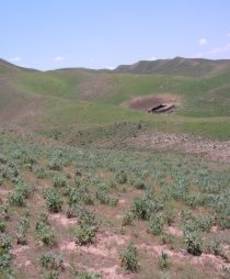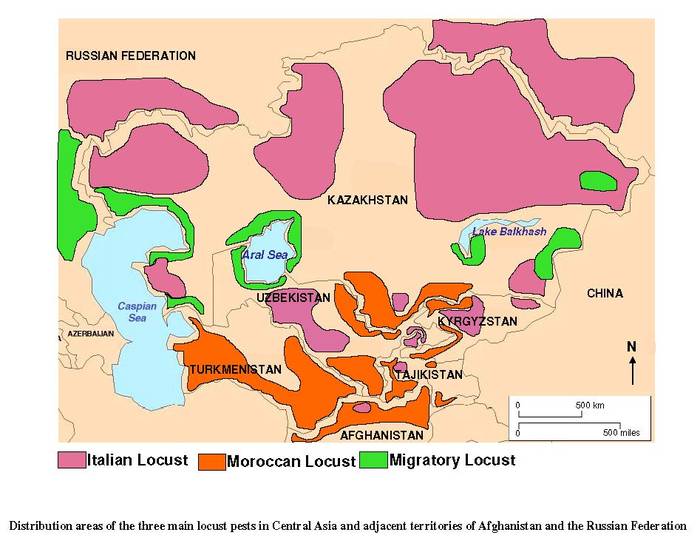Distribution areas in CCA

PRESENCE
The three considered species –the Italian Locust (CIT), the Moroccan Locust (DMA) and the Migratory Locust (LMI)- are present in all CCA countries. The largest area suitable for CIT is located in central and northern Kazakhstan. By decreasing size order, the largest permanent DMA breeding areas are situated in Uzbekistan, S. Kazakhstan, N. Afghanistan, as well as Tajikistan, Turkmenistan, Kyrgyzstan and Azerbaijan. LMI permanent breeding areas are confined to reed stands around water bodies, particularly in large river deltas of Kazakhstan, Uzbekistan and the Russian Federation (Ili, Amudarya, Syrdarya, etc.).
IMPORTANCE
The importance of the three species as well as the frequency and intensity of their outbreaks vary according to the countries. In CCA, the locust that can infest the largest surfaces in CCA is CIT (more than 11 million ha in 2000 in Kazakhstan). However, DMA generates the highest number of outbreaks in the highest number of countries.
More information on the importance of the three pests in the considered countries, based on occurrence and size of infestations and outbreaks, can be found in the table hereafter.
CROSS-BORDER INFESTATIONS
Both in Caucasus and Central Asia, borders are located across geographical entities and therefore often across permanent locust habitats and breeding areas. For that reason and because of the migratory nature of locusts, political borders are frequently crossed by locusts during back and forth movements of adult populations and by swarm flights. Such transboundary movements and flights create management problems in the border regions of adjacent countries.
The following parts of the different countries are concerned (see also above maps):
• Italian Locust (CIT)
During outbreaks, CIT infestations cover huge areas overlapping borders. Transboundary swarm flights, although not very frequent and lengthy, occur mainly between northern Kazakhstan and adjacent oblasts of the southern part of the Russian Federation, and between southern Georgia and Azerbaijan. The main hot spots (traditional breeding areas and outbreak areas) shared by neighboring countries are the following:
- Northern Kazakhstan and the Russian Federation, along a common border of 6 846 km long. To a lesser extent, western Kazakhstan and the Russian Federation (Volgograd oblast).
- Southern Kazakhstan and northern Kyrgyzstan sharing some CIT breeding areas along a common border of 1 051 km long,
- Southern Kyrgyzstan and northern Tajikistan, along the border of 870 km.
- Eastern Kazakhstan and China along a common border of 1 533 km long.
- Northern Armenia and southern Georgia.
- Eastern Armenia and western Azerbaijan.
- Southern Armenia and Iran.
- Western Armenia and Turkey.
• Moroccan Locust (DMA)
DMA represents a very serious transboundary issue, mostly in Central Asia. Many active breeding areas are located on both sides of the international borders and swarms arriving from a neighboring country have to be controlled by the recipient one in order to protect crops; consequently, the daily monitoring of transboundary back and forth movements of swarm or migrations is essential for DMA control strategy. The main hot spots (traditional breeding areas and outbreak areas) shared by neighboring countries are the following:
- A huge suitable area comprising northern Afghanistan, southern Tajikistan, southern Uzbekistan and south-eastern Turkmenistan, where permanent breeding areas are concentrated along the common borders and divided between these 4 adjacent countries.
- North-western Tajikistan and eastern Uzbekistan.
- Kazakhstan and northern Uzbekistan, where a severe outbreak developed in 2008.
- Southern Kazakhstan and northern Kyrgyzstan, sharing some DMA breeding areas along a common border of 1 051 km long.
- Kyrgyzstan and Uzbekistan.
- Kyrgyzstan and Tajikistan.
- Northern Azerbaijan and southern Georgia.
• Migratory Locust (LMI)
The main hot spots (traditional breeding areas, outbreak areas) shared by neighboring countries are the following:
- Western Kazakhstan and the Russian Federation;
- Eastern Kazakhstan and China.



